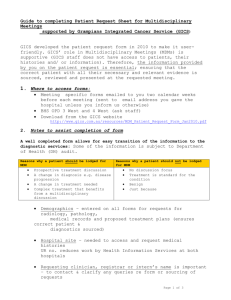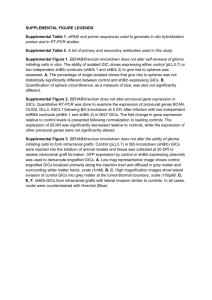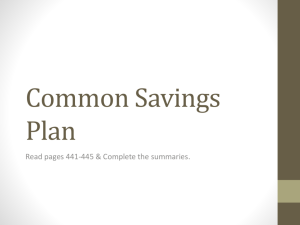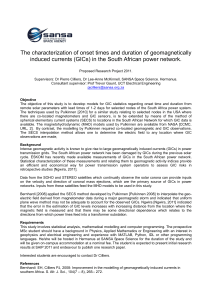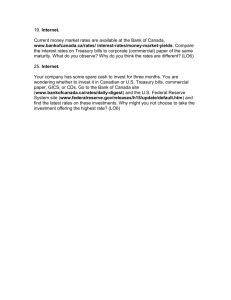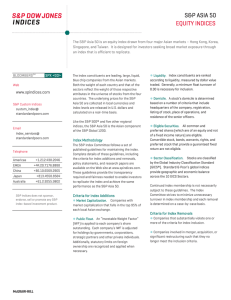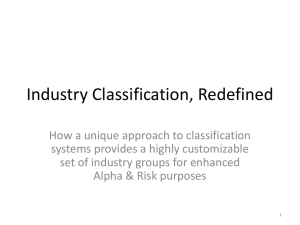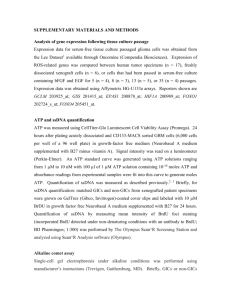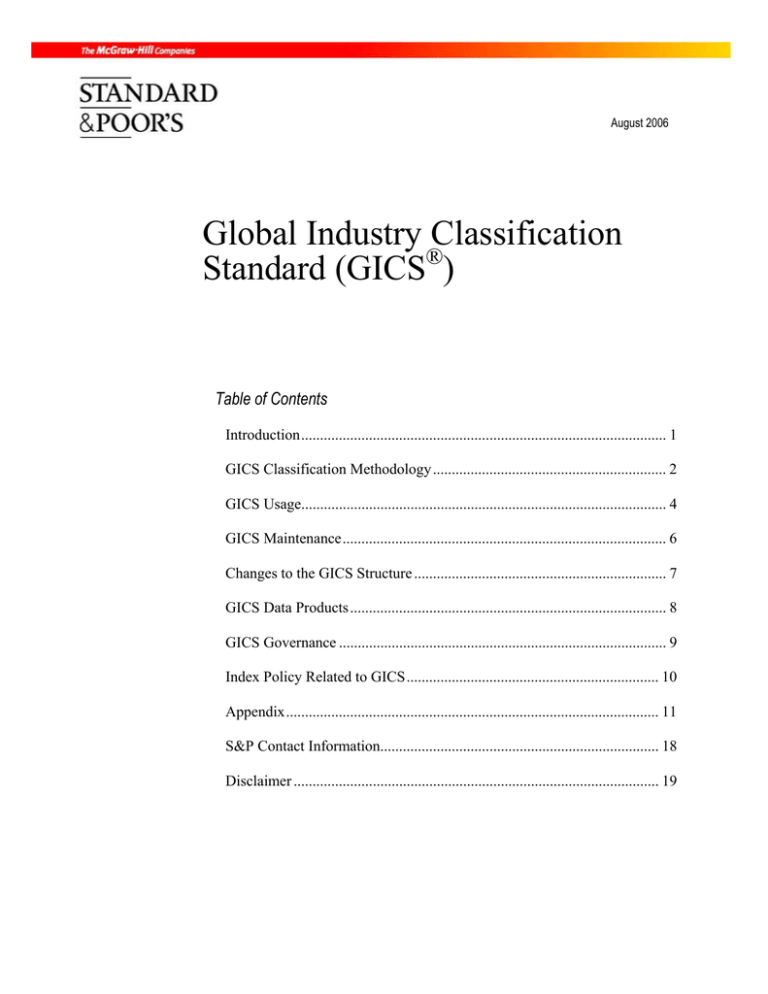
Global Industry Classification Standard (GICS®) Methodology
August 2006
August 2006
Global Industry Classification
Standard (GICS®)
Table of Contents
Introduction................................................................................................. 1
GICS Classification Methodology .............................................................. 2
GICS Usage................................................................................................. 4
GICS Maintenance...................................................................................... 6
Changes to the GICS Structure ................................................................... 7
GICS Data Products .................................................................................... 8
GICS Governance ....................................................................................... 9
Index Policy Related to GICS................................................................... 10
Appendix................................................................................................... 11
S&P Contact Information.......................................................................... 18
Disclaimer ................................................................................................. 19
Global Industry Classification Standard (GICS®) Methodology
August 2006
Introduction
In 1999, Standard & Poor’s and MSCI/Barra jointly developed the Global Industry
Classification Standard (GICS®) to establish a global standard for categorizing
companies into sectors and industries. GICS was developed in response to the global
financial community’s need for one complete, consistent set of global sector and
industry definitions, thereby enabling asset owners, asset managers and investment
research specialists to make seamless company, sector and industry comparisons
across countries, regions, and globally.
Highlights
GICS has become an industry model widely recognized by market participants
worldwide. It sets a foundation for the creation of replicable, custom-tailored
portfolios and enables meaningful comparisons of sectors and industries globally.
GICS was developed and is maintained by two leading global index providers. It has
been specifically designed to classify companies globally – in both developed and
developing economies.
The GICS methodology has been commonly accepted as an industry analysis
framework for investment research, portfolio management and asset allocation. The
GICS classification system currently consists of 10 sectors, 24 industry groups, 67
industries and 147 sub-industries. The GICS sectors are:
•
•
•
•
•
•
•
•
•
•
Consumer Discretionary
Consumer Staples
Energy
Financials
Health Care
Industrials
Information Technology
Materials
Telecommunication Services
Utilities
GICS was designed to classify a company according to its principal business activity.
To make this determination, Standard & Poor’s and MSCI use revenues as a key
measure of a company’s business activity. Earnings and market perception, however,
are also recognized as important and relevant information for classification purposes
and are taken into account during the review process.
Standard & Poor’s
Page 1
Global Industry Classification Standard (GICS®) Methodology
August 2006
GICS Classification Methodology
About GICS
GICS is designed to meet the needs of the investment community for a classification
system that reflects a company’s primary business model as determined by its
financial performance. Many other systems group companies into classifications
designed for tracking GDP and the economy rather than company performance. Over
34,000 active, publicly traded companies globally are currently classified and
maintained by S&P and MSCI according to the GICS methodology.
GICS Structure
GICS is a four-tiered, hierarchical industry classification system:
•
•
•
•
10 Sectors
24 Industry Groups
67 Industries
147 Sub-Industries
GICS classifications can be presented in text or numeric format. The full GICS
classification for each company is an 8-digit code with text description. The
hierarchical design of the 8-digit coding system allows for easy transition between
GICS tiers.
Examples:
Standard & Poor’s
Sector:
Industry Group:
Industry:
Sub-industry:
Consumer Discretionary (GICS code: 25)
Consumer Services (GICS code: 2530)
Hotels, Restaurants & Leisure (GICS code: 253010)
Casinos & Gaming (GICS code: 25301010)
Sector:
Industry Group:
Industry:
Sub-industry:
Financials (GICS code: 40)
Diversified Financials (GICS code: 4020)
Capital Markets (GICS code: 402030)
Investment Banking & Brokerage (GICS code: 40203020)
Page 2
Global Industry Classification Standard (GICS®) Methodology
August 2006
GICS Compliant Indices
Standard & Poor’s has long been a leading provider of indices used by the
international financial markets for portfolio analysis and asset management. By
developing indices using the GICS structure, S&P presents a powerful family of
sector-based indices that offer a global, consistent set of benchmarks.
For more information on GICS-based index products at Standard & Poor’s, please
visit our Web site at www.indices.standardandpoors.com.
GICS enables both S&P and any index provider who adopts the system to develop
competing sector indices and index products from a common global standard.
An index that is GICS-compliant is one that is derived, bottom-up, using GICS as the
industry classification methodology -- specifically the unique, company-to-issue level
classification as determined by S&P and MSCI.
GICS Assignments
Standard & Poor’s and MSCI jointly assign a company to a single GICS sub-industry
according to the definition of its principal business activity as determined by the two
companies. Revenues are a significant factor in determining principal business
activity; however, earnings and market perception are also important criteria for
classification.
If a company’s subsidiary files separate financials to its reporting government agency,
that subsidiary will be considered a separate entity and classified independently under
the GICS methodology. Equity securities or issues directly linked to a company will
have the same classification as the company.
Standard & Poor’s
Page 3
Global Industry Classification Standard (GICS®) Methodology
August 2006
GICS Usage
GICS Usage at S&P
GICS is the official Standard & Poor's industry classification system. Most
Standard & Poor's products that include an industry classification system use the GICS
structure.
All companies in the Standard & Poor’s global family of indices have been classified
according to the GICS structure. Standard & Poor’s indices and sub-indices are
designed to reflect the sectoral composition of the broad markets they represent.
Many of the broad S&P indices are broken down into sector- and/or industry-level
indices to provide performance measurements across these markets. The sector
weights of an S&P index provide the financial community with a useful benchmark of
sectors representation within that market.
While Standard & Poor’s equity indices have set the foundation for GICS and GICS
usage, many other S&P products incorporate GICS into their products. These include,
but are not limited to:
•
•
•
•
•
•
•
•
S&P Global Indices
Stock Reports
Sector Scorecards
Compustat
Research Insight
Analysts’ Handbook
Capital IQ
CreditPro, Ratings Direct, and RatingsXpress
GICS Usage in the Market
Investors use GICS and all related industry indices and data across the full spectrum of
equity market investing – including asset management, sector research, portfolio
strategy, peer analysis, and client account reporting. The use of GICS enables market
participants to identify and analyze a customized group of companies from a common
global standard. The use of this global standard helps strategists, analysts, and
investors compare companies outside of their local markets and attract capital into
local markets when comparing stocks within the same industry. GICS helps market
participants determine whether stock movements are locally based or are part of a
broader global trend.
Standard & Poor’s
Page 4
Global Industry Classification Standard (GICS®) Methodology
August 2006
The GICS methodology has been widely accepted as an industry analysis framework
for investment research, portfolio management and asset allocation. Its universal
approach to industries worldwide has contributed to transparency and efficiency in the
investment process, and the GICS methodology supports the trend towards sectorbased investing.
GICS defines peer groups tightly and avoids grouping unlike companies together.
Four classification levels allow for more customization and targeting in portfolio,
index and derivative product construction.
Investors use GICS and all related S&P industry indices and data across the full
spectrum of equity market management – including asset management, sector
research, portfolio strategy, peer analysis, and client account reporting. The use of
GICS enables market participants to identify and analyze a customized group of
companies from a common global standard.
Market participants currently using the GICS structure include buy-side portfolio
managers, institutional and retail brokerage firms, custodians, universities, consultants,
and a variety of data distributors.
Standard & Poor’s
Page 5
Global Industry Classification Standard (GICS®) Methodology
August 2006
GICS Maintenance
GICS Reviews
Companies are reviewed annually at a minimum. Companies are also under constant
surveillance for corporate actions.
In general, a GICS code will change whenever there is a major corporate action that
redefines a company's primary line of business. At a minimum, annual reviews are
conducted to ensure that a company has not redefined its line of business through a
series of smaller events.
GICS reviews will also occur upon client request through the use of the GICS email
box, spgics@standardandpoors.com.
GICS Structure Review
Standard & Poor’s and MSCI review the GICS structure on an annual basis.
Frequently this is done through an open consultation. The objective is to ensure that
the GICS structure continues to accurately represent the global equity markets, and
thereby, enables asset owners, asset managers and investment research specialists to
make seamless global comparisons by industry.
Standard & Poor’s
Page 6
Global Industry Classification Standard (GICS®) Methodology
August 2006
Changes to the GICS Structure
The four-level GICS structure accurately reflects equities in today’s global investment
environment, yet is flexible enough to capture tomorrow’s developments. The eightdigit GICS coding system is designed to adapt easily to the changing investment
world. As the global economy changes, sectors, industry group, industries and subindustries can be added or divided.
The chronology of the GICS structures is as follows:
Date
August 1999
March 2002
April 2003
April 2004
April 2005
April 2006
GICS Event
GICS introduced. GICS comprised of 10 sectors, 23 industry groups, 59
industries and 123 sub-industries.
The total number of sub-industries in the GICS structure reduced to 122
from 123. Name and description changes to other GICS categories.
GICS comprised of 10 sectors, 23 industry groups, 59 industries and 122
sub-industries.
Changes included the creation of new industry groups, industries and
sub-industries, the merger of some existing sub-industries and
significant name and definition changes to others. GICS comprised of
10 sectors, 24 industry groups, 62 industries and 132 sub-industries.
Changes limited to definition changes for some of the GICS subindustries. GICS comprised of 10 sectors, 24 industry groups, 62
industries and 132 sub-industries.
Changes included renaming and redefining one industry group, creating
two industries and seven sub-industries, and making significant name
and definition changes to others. GICS comprised of 10 sectors, 24
industry groups, 64 industries and 139 sub-industries.
Changes included renaming one industry group, creating four new
industries and ten new sub-industries. Changes also included
discontinuing one industry and two sub-industries, and making name
and definition changes to others. GICS comprised of 10 sectors, 24
industry groups, 67 industries and 147 sub-industries.
Detailed information on the changes to the GICS structures can be found on
Standard & Poor’s Web site at www.gics.standardandpoors.com.
Standard & Poor’s
Page 7
Global Industry Classification Standard (GICS®) Methodology
August 2006
GICS Data Products
GICS Direct
GICS DirectSM, a joint product of Standard & Poor’s and MSCI, was introduced in
2001. GICS Direct provides industry classifications for more then 34,000 active
companies and 38,000 active securities. S&P and MSCI estimate that GICS Direct
covers approximately 98% of the world’s equity market capitalization.
GICS History
Standard & Poor's GICS History is a valuable tool for statistical analysis, back-testing
and historic sector performance attribution. GICS History provides historical
classifications on over 25,000 active and inactive U.S. companies, Canadian
companies, and ADRs
For more information on GICS Direct and GICS History, please visit
Standard & Poor’s Web site www.standardandpoors.com.
Standard & Poor’s
Page 8
Global Industry Classification Standard (GICS®) Methodology
August 2006
GICS Governance
GICS Methodology Committee
The GICS methodology and structure fall under the overall supervision of the GICS
Operations Committee, with members from both S&P and MSCI. The Committee
will from time to time consult the financial markets in order to keep the methodology
current and relevant.
Standard & Poor’s and MSCI considers information about changes to the GICS
structure and related matters to be potentially market moving and material. Therefore,
all Committee discussions are confidential.
Standard & Poor’s
Page 9
Global Industry Classification Standard (GICS®) Methodology
August 2006
Index Policy Related to GICS
Announcements
Announcements of GICS changes to companies in S&P indices follow the guidelines
of the index methodologies.
Please refer to the individual index methodologies for treatment of GICS classification
changes.
Standard & Poor’s
Page 10
Global Industry Classification Standard (GICS®) Methodology
August 2006
Appendix
The Current GICS Structure
Standard & Poor’s
Page 11
Global Industry Classification Standard (GICS) Methodology
August 2006
Sector
Industry Group
Industry
10
1010
101010
Energy Equipment & Services
101020
Oil, Gas & Consumable Fuels
151010
Chemicals
151020
151030
Construction Materials
Containers & Packaging
151040
Metals & Mining
151050
Paper & Forest Products
201010
201020
201030
201040
Aerospace & Defense
Building Products
Construction & Engineering
Electrical Equipment
201050
201060
Industrial Conglomerates
Machinery
201070
Trading Companies &
Distributors
15
20
Energy
Materials
Industrials
Standard & Poor’s
1510
2010
Energy
Materials
Capital Goods
Sub-Industry
10101010
10101020
10102010
10102020
10102030
10102040
10102050
Oil & Gas Drilling
Oil & Gas Equipment & Services
Integrated Oil & Gas
Oil & Gas Exploration & Production
Oil & Gas Refining & Marketing
Oil & Gas Storage & Transportation
Coal & Consumable Fuels
15101010
15101020
15101030
15101040
15101050
15102010
15103010
15103020
15104010
15104020
15104030
15104040
15104050
15105010
15105020
Commodity Chemicals
Diversified Chemicals
Fertilizers & Agricultural Chemicals
Industrial Gases
Specialty Chemicals
Construction Materials
Metal & Glass Containers
Paper Packaging
Aluminum
Diversified Metals & Mining
Gold
Precious Metals & Minerals
Steel
Forest Products
Paper Products
20101010
20102010
20103010
20104010
20104020
20105010
20106010
Aerospace & Defense
Building Products
Construction & Engineering
Electrical Components & Equipment
Heavy Electrical Equipment
Industrial Conglomerates
Construction & Farm Machinery & Heavy
Trucks
Industrial Machinery
Trading Companies & Distributors
20106020
20107010
Page 12
Global Industry Classification Standard (GICS) Methodology
August 2006
Sector
Industry Group
Industry
20
2020
202010
Industrials (cont’d)
Commercial
Services & Supplies
Sub-Industry
Commercial Services & Supplies
20201010
Commercial Printing
20201020
20201040
20201050
20201060
20301010
20302010
20303010
20304010
20304020
20305010
20305020
20305030
Data Processing Services -- Discontinued
effective 04/30/2003.
Diversified Commercial & Professional
Services
Human Resource & Employment Services
Environmental & Facilities Services
Office Services & Supplies
Air Freight & Logistics
Airlines
Marine
Railroads
Trucking
Airport Services
Highways & Railtracks
Marine Ports & Services
25101010
Auto Parts & Equipment
25101020
25102010
25102020
25201010
Tires & Rubber
Automobile Manufacturers
Motorcycle Manufacturers
Consumer Electronics
25201020
25201030
25201040
25201050
25202010
25202020
25203010
Home Furnishings
Homebuilding
Household Appliances
Housewares & Specialties
Leisure Products
Photographic Products
Apparel, Accessories & Luxury Goods
25203020
25203030
Footwear
Textiles
20201030
2030
25
Consumer
Discretionary
2510
2520
Standard & Poor’s
Transportation
Automobiles &
Components
Consumer Durables
& Apparel
203010
203020
203030
203040
Air Freight & Logistics
Airlines
Marine
Road & Rail
203050
Transportation Infrastructure
251010
Auto Components
251020
Automobiles
252010
Household Durables
252020
Leisure Equipment & Products
252030
Textiles, Apparel & Luxury
Goods
Page 13
Global Industry Classification Standard (GICS) Methodology
August 2006
Sector
Industry Group
Industry
25
2530
253010
Hotels, Restaurants & Leisure
253020
Diversified Consumer Services
30
Consumer
Discretionary
(cont’d)
Consumer Staples
25301010
25301020
25301030
25301040
25302010
25302020
25401010
25401020
25401030
25401040
25501010
25502010
25502020
25503010
25503020
25504010
25504020
25504030
25504040
25504050
25504060
Casinos & Gaming
Hotels, Resorts & Cruise Lines
Leisure Facilities
Restaurants
Education Services
Specialized Consumer Services
Advertising
Broadcasting & Cable TV
Movies & Entertainment
Publishing
Distributors
Catalog Retail
Internet Retail
Department Stores
General Merchandise Stores
Apparel Retail
Computer & Electronics Retail
Home Improvement Retail
Specialty Stores
Automotive Retail
Homefurnishing Retail
2540
Media
254010
Media
2550
Retailing
255010
255020
Distributors
Internet & Catalog Retail
255030
Multiline Retail
255040
Specialty Retail
301010
Food & Staples Retailing
30101010
Drug Retail
Beverages
30101020
30101030
30101040
30201010
Food Distributors
Food Retail
Hypermarkets & Super Centers
Brewers
30201020
30201030
30202010
30202020
Distillers & Vintners
Soft Drinks
Agricultural Products
Meat, Poultry & Fish (discontinued, effective
March 28 2002)
Packaged Foods & Meats
Tobacco
3010
3020
Standard & Poor’s
Consumer Services
Sub-Industry
Food & Staples
Retailing
Food, Beverage &
Tobacco
302010
302020
Food Products
302030
Tobacco
30202030
30203010
Page 14
Global Industry Classification Standard (GICS) Methodology
August 2006
Sector
Industry Group
Industry
30
3030
303010
Household Products
30301010
Household Products
303020
Personal Products
30302010
Personal Products
351010
Health Care Equipment &
Supplies
35101010
Health Care Equipment
351020
Health Care Providers &
Services
35101020
35102010
Health Care Supplies
Health Care Distributors
Health Care Services
Health Care Facilities
Managed Health Care
Health Care Technology
Biotechnology
35
Consumer Staples
(cont’d)
Health Care
3510
3520
40
Financials
Health Care
Equipment &
Services
Pharmaceuticals,
Biotechnology &
Life Sciences
4010
Banks
4020
Diversified
Financials
4030
Standard & Poor’s
Household &
Personal Products
Insurance
Sub-Industry
351030
352010
Health Care Technology
Biotechnology
35102015
35102020
35102030
35103010
35201010
352020
352030
Pharmaceuticals
Life Sciences Tools & Services
35202010
35203010
Pharmaceuticals
Life Sciences Tools & Services
401010
Commercial Banks
401020
402010
Thrifts & Mortgage Finance
Diversified Financial Services
40101010
40101015
40102010
40201010
Diversified Banks
Regional Banks
Thrifts & Mortgage Finance
Consumer Finance -- Discontinued effective
04/30/2003.
Other Diversified Financial Services
Multi-Sector Holdings
Specialized Finance
Consumer Finance
Asset Management & Custody Banks
Investment Banking & Brokerage
Diversified Capital Markets
Insurance Brokers
Life & Health Insurance
Multi-line Insurance
Property & Casualty Insurance
Reinsurance
402020
402030
Consumer Finance
Capital Markets
403010
Insurance
40201020
40201030
40201040
40202010
40203010
40203020
40203030
40301010
40301020
40301030
40301040
40301050
Page 15
Global Industry Classification Standard (GICS) Methodology
August 2006
Sector
Industry Group
Industry
40
4040
404010
Financials (cont’d)
Real Estate
Sub-Industry
Real Estate -- Discontinued
effective 04/28/2006
40401010
40402010
Real Estate Investment Trusts -Discontinued effective 04/28/2006
Real Estate Management & Development -Discontinued effective 04/28/2006
Diversified REITs
40402020
40402030
40402040
40402050
40402060
40402070
40403010
Industrial REITs
Mortgage REITs
Office REITs
Residential REITs
Retail REITs
Specialized REITs
Real Estate Management & Development
40401020
404020
45
Information
Technology
4510
4520
Software & Services
Technology
Hardware &
Equipment
Real Estate Investment Trusts
(REITs)
404030
Real Estate Management &
Development
451010
Internet Software & Services
45101010
Internet Software & Services
451020
IT Services
451030
Software
452010
Communications Equipment
45102010
45102020
45103010
45103020
45103030
45201020
IT Consulting & Other Services
Data Processing & Outsourced Services
Application Software
Systems Software
Home Entertainment Software
Communications Equipment
45201010
45202010
45202020
45203010
Networking Equipment -- Discontinued
effective 04/30/2003.
Telecommunications Equipment -Discontinued effective 04/30/2003.
Computer Hardware
Computer Storage & Peripherals
Electronic Equipment Manufacturers
45203020
45203030
Electronic Manufacturing Services
Technology Distributors
45201020
Standard & Poor’s
452020
Computers & Peripherals
452030
Electronic Equipment &
Instruments
Page 16
Global Industry Classification Standard (GICS) Methodology
Sector
45
Industry Group
Information
Technology (cont’d)
4530
50
55
Telecommunication
Services
Utilities
Standard & Poor’s
5010
5510
Semiconductors &
Semiconductor
Equipment
Telecommunication
Services
Utilities
August 2006
Industry
Sub-Industry
452040
Office Electronics
45204010
Office Electronics
452050
Semiconductor Equipment &
Products -- Discontinued
effective 04/30/2003.
45205010
Semiconductor Equipment -- Discontinued
effective 04/30/2003.
45205020
45301010
Semiconductors -- Discontinued effective
04/30/2003.
Semiconductor Equipment
45301020
Semiconductors
50101010
Alternative Carriers
50101020
50102010
Integrated Telecommunication Services
Wireless Telecommunication Services
55101010
55102010
55103010
55104010
55105010
Electric Utilities
Gas Utilities
Multi-Utilities
Water Utilities
Independent Power Producers & Energy
Traders
453010
Semiconductors &
Semiconductor Equipment
501010
Diversified Telecommunication
Services
501020
Wireless Telecommunication
Services
551010
551020
551030
551040
551050
Electric Utilities
Gas Utilities
Multi-Utilities
Water Utilities
Independent Power Producers &
Energy Traders
Page 17
Global Industry Classification Standard (GICS) Methodology
August 2006
S&P Contact Information
Index Management
David M. Blitzer, Ph.D. – Managing Director & Chairman of the Index Committee
david_blitzer@standardandpoors.com
1 212 438 3907
Maureen Maitland – Vice President, Index Analysis and Management
maureen_maitland@standardandpoors
1 212 438 1178
Media Relations
David Guarino – Communications
dave_guarino@standardandpoors.com
1 212 438 1471
Sales and Marketing
North America
New York
Wendy Chan
Maureen O’Shea
Toronto
Jasmit Bhandal
Tony North
Europe
Paris
Christopher O’Brien
London
Susan Fagg
Asia
Hong Kong
Jean Park
Beijing
Andrew Webb
Tokyo
Seiichiro Uchi
Sydney
Jason Hill
Standard & Poor’s
1 212 438 4080
1 212 438 2046
1 416 507 3203
1 416 507 3204
33 (0) 1 40 75 77 91
44 (0) 20 7176 8388
852 2841 1032
8610 6535 2919
81 3 4550 8568
61 2 9255 9872
Page 18
Global Industry Classification Standard (GICS) Methodology
August 2006
Disclaimer
The report is published by Standard & Poor’s, 55 Water Street, New York, NY 10041.
Copyright © 2006. Standard & Poor’s is a division of The McGraw-Hill Companies,
Inc. All rights reserved. Standard & Poor’s does not undertake to advise you of
changes in the information contained in this report.
These materials have been prepared solely for informational purposes based upon
information generally available to the public from sources believed to be reliable.
Standard & Poor’s makes no representation with respect to the accuracy or
completeness of these materials, the content of which may change without notice.
Standard & Poor’s disclaims any and all liability relating to these materials and makes
no express or implied representations or warranties concerning the accuracy or
completeness of the report.
No portion of this publication may be reproduced in any format or by any means
including electronically or mechanically, by photocopying, recording or by any
information storage or retrieval system, or by any other form or manner whatsoever,
without the prior written consent of Standard & Poor’s.
Analytic services and products provided by Standard & Poor’s are the result of
separate activities designed to preserve the independence and objectivity of each
analytic process. Standard & Poor’s has established policies and procedures to
maintain the confidentiality of non-public information received during each analytic
process.
Standard & Poor’s
Page 19

